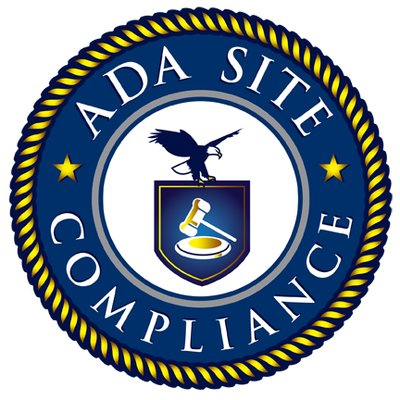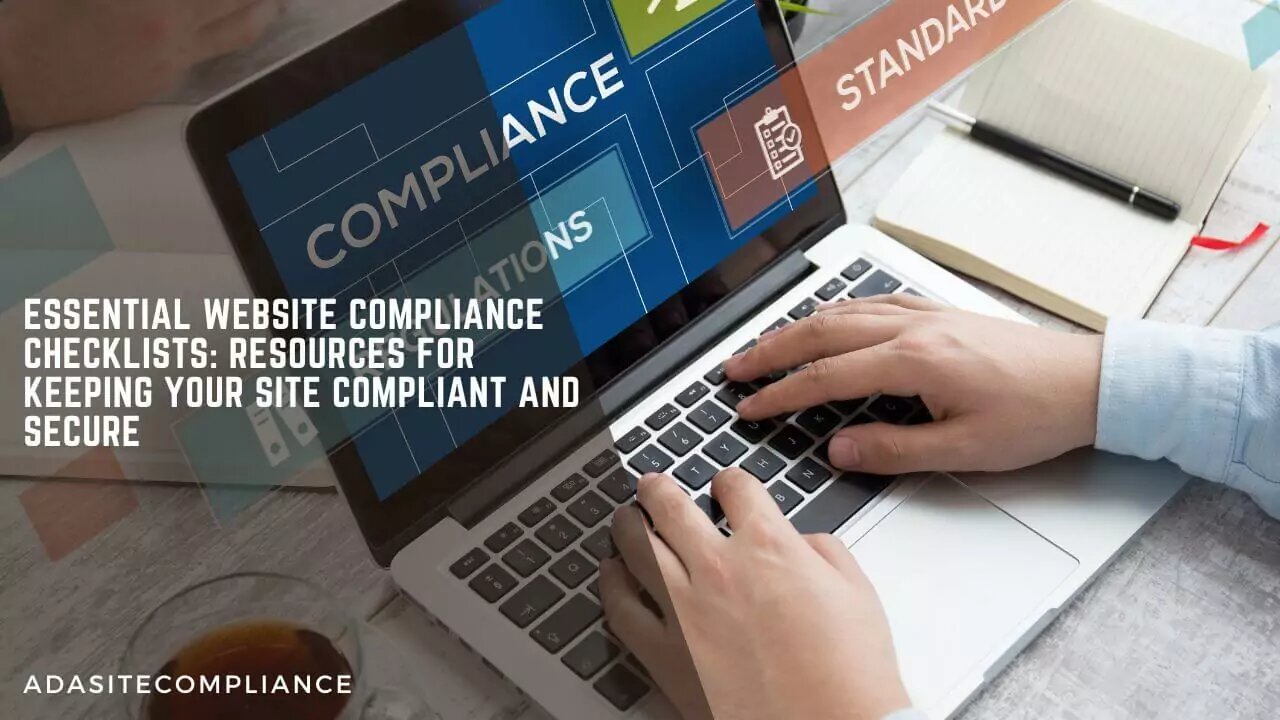ADA Website Accessibility Guidelines
 ADA Site Compliance
ADA Site Compliance
Essential Website Compliance Checklists: Resources for Keeping Your Site Compliant and Secure
It might be surprising, but the Americans with Disabilities Act (ADA) does not specifically address websites. This has led to uncertainty about whether websites must comply with ADA regulations. Despite this ambiguity, it remains crucial to ensure that your website is ADA-compliant to ensure accessibility for all users.
Every organization should have a solid understanding of ADA website compliance guidelines. By familiarizing yourself with ADA requirements, you can reduce the risk of costly lawsuits resulting from ADA violations.
Navigating the ever-changing landscape of web accessibility laws can be challenging for businesses and organizations. ADA Site Compliance is here to help you achieve compliance with the California Consumer Privacy Act (CCPA) on your website.
Our knowledgeable compliance professionals stay updated on the latest trends and legislation to ensure your website meets the necessary standards. By prioritizing website accessibility, you can enhance your business’s overall performance and boost your bottom line.
Delving into the Fundamentals of ADA Certification for Websites
The Americans with Disabilities Act (ADA) was formally enacted in 1991. Initially focusing on physical barriers, the ADA ensures equal access to public spaces. However, with the rise of digital environments, the issue of accessibility has expanded to include online platforms.
In recent years, there has been a notable shift in the interpretation of ADA regulations by federal agencies and courts, particularly the Department of Justice (DOJ). Despite the absence of specific government policies addressing web accessibility, courts increasingly recognize the importance of ensuring equal access to digital platforms for individuals with disabilities.
Consequently, websites must prioritize ADA compliance to ensure accessibility for all users, adhere to legal standards, and promote inclusivity online.
Understanding the Link Between web content accessibility guidelines and ADA Compliance
Establishing a clear understanding of how the Web Content Accessibility Guidelines (WCAG) align with the Americans with Disabilities Act (ADA) is crucial for ensuring digital accessibility. Following the Rehabilitation Act 2017 update to Section 508, government agencies and their contractors must adhere to WCAG 2.0 A/AA standards explicitly.
Despite the absence of precise standards for commercial businesses under the ADA, they are still expected to ensure accessibility within their establishments.
While WCAG serves as the de facto standard for web accessibility, adherence to these guidelines is recommended, as past Department of Justice (DOJ) cases have underscored WCAG’s significance in legal rulings. Although WCAG 2.0 AA is considered the minimum standard, striving for compliance with WCAG 2.1 AA or WCAG 2.2 is advisable to future-proof your existing website too.
WCAG 2.1 and its successor, WCAG 2.2, aim to improve upon previous versions and address emerging trends, such as the increasing use of mobile devices for internet access. WCAG 2.2 encompasses all WCAG 2.1 guidelines while accommodating multiple disabilities across various devices.
Despite not being officially adopted into law by the Department of Justice, WCAG guidelines remain the globally recognized standard for ADA compliance. Therefore, adherence to WCAG criteria is essential for creating a fair and inclusive online environment for all individuals, regardless of their abilities. Non-compliance may result in legal ramifications.
Which Websites Must Comply with the Americans with Disabilities Act (ADA)?
All websites, except for personal, hobby, and professional blogs, must comply with the standards set forth by the Americans with Disabilities Act (ADA). Whether a website is used for informational or commercial purposes, adherence to ADA web requirements is essential. Additionally, websites facilitating online transactions, such as e-commerce platforms, must ensure ADA compliance.
A few steps that can be taken to achieve compliance with WCAG 2.1 Level A are:
To prevent seizures, ensure your website has no content that could potentially trigger seizures.
Fast-strobing lights, for instance, have been known to induce seizures in some individuals.
Mere warnings about flashing content are insufficient; instead, design your content to mitigate the risk of seizures.
Any element that flashes more than three times in a single second should be avoided on websites.
Gaining In-Depth Insights into Website Security Compliance
Ensuring robust website security measures is vital for safeguarding your digital assets effectively. These compliance standards are designed to bolster your organization and instill confidence among stakeholders by fostering a secure online environment.
They encompass a broad spectrum of security elements, spanning data protection, privacy safeguards, auditing procedures, incident reporting protocols, and more. Acknowledging that compliance is ongoing, requiring regular updates, continuous monitoring, and proactive engagement is crucial for sustained adherence.
Embracing these standards enhances your credibility and underscores your unwavering commitment to safeguarding customer interests.
Is your Website at Legal Risk Due to Non-Compliance with ADA Standards?
The surge in federal lawsuits against businesses and government entities for inaccessible websites is concerning. High-profile cases demonstrate that no organization is immune to the legal consequences of ADA violations.
For instance, Parkwood Entertainment, owned by Beyoncé, faced legal action for lacking image alt text on its website. Similarly, Harvard University and MIT were sued for not providing captions for those with hearing impairments.
While these cases garner attention, many small businesses face similar legal challenges under the radar. When hit with a lawsuit, businesses incur expenses covering the plaintiff’s legal fees and their legal costs and must implement website improvements.
The financial toll of inaction can be staggering. Investing in web accessibility is a prudent financial decision to mitigate the risk of lawsuits. Proactive risk management remains the most effective form of protection until the Department of Justice establishes clear standards.
ADA Website Compliance Checklist
This comprehensive ADA compliance checklist is designed to ensure compliance with the latest accessibility standards outlined in WCAG 2.1. It covers three levels of compliance: Level A, Level AA, and Level AAA. While achieving Level AA compliance is recommended for all websites, some tools can streamline the process.
1. Enhancing Button Accessibility
Implementing accessible naming conventions and ARIA labels across all website buttons is crucial for facilitating navigation for users with visual or auditory impairments.
2. Alt Text for Enhanced Accessibility
Ensure your website caters to all visitors by providing descriptive alt text for graphical elements like images and buttons.
3. Skip Navigation for Seamless Access
Incorporate skip navigation links to empower users relying on keyboard navigation or screen readers for easy access to your website’s main content.
4. Organize Content Hierarchy
Use bold headers and subheadings to organize page content effectively and communicate its importance to readers.
5. Descriptive Anchor Text for Clarity
Make outbound links more accessible by using descriptive anchor text that is easily understandable and clickable for users and search engines alike.
6. Keyboard Navigation Accessibility
Enable seamless navigation and accessible websites for individuals with disabilities by ensuring all website elements can be accessed using a keyboard.
7. Streamlined Error Reporting
Implement a user-friendly system for reporting all accessibility violations and barriers, allowing for prompt resolution and rectification.
8. Prominently Display Contact Information
Enhance user accessibility by prominently displaying your organization’s contact details, facilitating communication for those seeking assistance with access controls or information related to accessibility.
Ensuring Consistent Compliance Through Thorough Security Audits
Maintaining the security and reliability of your online platform requires strict adherence to industry regulations and standards. Conducting regular security audits is essential to uphold compliance. During these audits, your security infrastructure, including the web application firewall (WAF), undergoes meticulous evaluation to assess its alignment with relevant regulatory standards.
An audit identifies potential security vulnerabilities and provides valuable insights for enhancing your overall security posture. These audits demonstrate your commitment to robust security best practices and provide tangible evidence of your organization’s adherence to regulatory requirements.
Selecting Expert Website Audit Services for Enhanced Security
Securing your online presence demands partnering with a reputable website auditing firm like ADA Site Compliance, renowned for its expertise. Our seasoned professionals in this field possess the knowledge and capabilities to evaluate website security protocols thoroughly.
We dive deep into data protection measures and can thus offer tailored recommendations to mitigate risks effectively. Moreover, their adeptness with compliance standards ensures your website meets regulatory requirements, fostering customer trust and safeguarding your brand integrity in the digital landscape.
Conclusion
Updating your website to meet ADA compliance standards requires significant time and effort. The Americans with Disabilities Act mandates strict adherence, underscoring the importance of taking proactive steps promptly.
Navigating the complex web accessibility regulations can be daunting for businesses. At ADA Site Compliance, we specialize in achieving CCPA website compliance and can provide expert guidance. Our team thoroughly analyses your current website and offers assistance in redesigning it to ensure equal access to all users. Contact us today, or get your free site scan here.
Additionally, we offer training and ongoing support to help you maintain compliance with evolving regulations. Our compliance professionals stay abreast of the latest laws and standards, ensuring your website meets all requirements. Prioritizing website accessibility enhances your overall performance and increases profitability!
Subscribe to my newsletter
Read articles from ADA Site Compliance directly inside your inbox. Subscribe to the newsletter, and don't miss out.
Written by

ADA Site Compliance
ADA Site Compliance
All websites are required to be accessible by people with disabilities. If they are not, this is a violation of the Americans with Disabilities Act (ADA)!